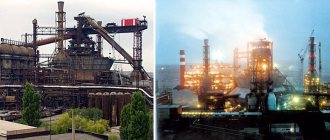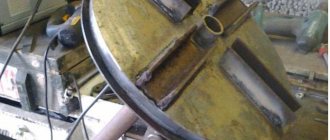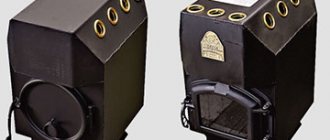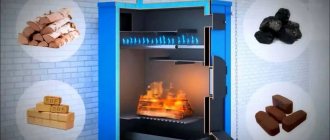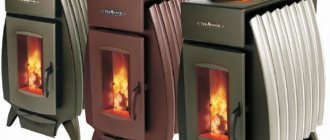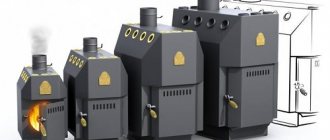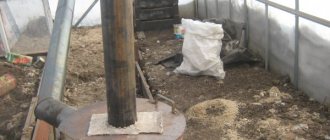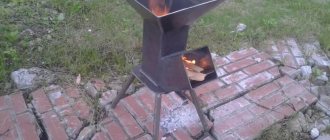“Long-burning stoves” is a case where the name speaks for itself! In such stoves, wood burns for six, eight, or even twelve hours, well, isn’t that great! But every coin, as they say, has two sides, which we will consider further. Let us immediately note that there is no need to confuse long-burning stoves (for example, “Buleryan” or “Breneran”) and stoves with a long-burning function (we wrote about this function earlier in the article “Choosing a wood-burning stove for a home.”) Now we will talk specifically about stoves in which long-term burning is the principle of operation, and not just an additional function.
To clearly understand the pros and cons of long-term combustion, it is necessary to understand how the process itself occurs and what depends on what.
Construction of a long-burning furnace
The oven is designed as follows:
- combustion chamber (fuel tank), which has two compartments: one for burning fuel, the other for burning combustion products. The latter is made in the form of a dome;
- chimneys (optimal diameter within 80 - 150 mm), through which combustion products are removed;
- some models are equipped with an air convection system or a water heat exchanger;
- slabs may be included in the design; ovens, etc.
Specifications
The technical parameters of wood heaters depend on the material and manufacturer. Since brick structures are most often built in private houses, it is advisable to consider their parameters:
- comfortable room temperature – +23 degrees;
- thickness of the convection screen (if available) – 30-40 mm;
- scope of operation – heating, cooking, additional heating;
- weight – from 250 kg without metal parts;
- type of foundation – solid cast, strip;
- the size of the metal sheet in front of the firebox is at least 30x40 cm;
- chimney cross-section – from 140x140 mm to 200x270 mm;
- thermal power – from 3.5 to 14 kW.
A small stove for a sauna with an open heater.
For a sauna, you can build a mini-stove that runs on wood with the following characteristics:
- heat output - 12.1 kW;
- width – 50.5 cm;
- height to pipe – 72.5 cm;
- depth of the combustion compartment – 73.7 cm;
- weight – 360-370 kg.
The efficiency of the finished unit will be 70-75%.
Operating principle of long-burning furnaces
The operating principle of long-burning furnaces is fundamentally different from the functioning of a conventional heating device. The operation of a long-burning stove is based on the spread of fire from top to bottom. The fuel is ignited at the top thanks to the use of an air supply pipe. When burning, gases are sucked out through the chimney. The air supply is controlled by a damper: the combustion process is transformed into smoldering. This functionality allows for heat dissipation for many hours and even days.
The processes in the furnace are carried out as follows:
- drying of fuel (energy carrier);
- pyrolysis (decomposition); prerequisites - lack of oxygen, temperature about 450ºC;
- combustion of volatile (light) fractions with parallel carbonization (saturation with carbon dioxide) of the fuel;
- decomposition of solid fuel fractions and their transition to a volatile state;
- oxidation reaction (production of hydrogen and carbon monoxide) at a temperature of 400ºC.
The result of oxidation (reduction) is the release of a large amount of heat. Mandatory condition: the temperature should not fall below 250 ºC. Otherwise, hydrogen and carbon monoxide will escape. No heat will be transferred.
Stove options that are in high demand. TOP-7 domestic market
The most popular models of long-burning stoves are:
Canadian Buleryan stoves are pioneers of technology
These are products of the Canadian company of the same name, which are widely used in North America and European countries.
The first working prototype was created by Eric Darnell in 1975 . The man noticed the low productivity of a conventional wood stove and improved the design by installing a fire-resistant metal pipe.
The modernized furnace gave excellent results, so Eric, together with two partners, founded the FREE FLOW company and set up mass production.
5 years later , entrepreneur Erhard Knofler, a German by birth, saw such a stove in one of the Canadian bars. The businessman saw great potential in this, so he bought all the rights to the invention and founded the ENERGETEC company and registered the BULLERJAN trademark.
The company operates to this day, with its head office located in the German city of Iserhagen.
Currently, the manufacturer's lineup looks like this:
- Type 00 – power 6 kW , intended for rooms with an area of 100 m2 . Weight: 57 kg .
- Type 01 – power 11 kW , heated area 200 m2 . Product weight – 108 kg .
- Type 02 – capacity 18 kW , heats rooms up to 400 m2 . Structural weight – 130 kg .
- Type 02M is a modernized version, with a power of 24 kW and a heated area of 500 m2 . Stove weight 145 kg .
- Type 03 – power 27 kW , heating area 600 m2 . Weight: 169 kg .
- Type 04 – 35 kW , which allows heating 1,000 m2 of living space. Weight: 215 kg .
It should be noted that the above models differ not only in weight and performance, but also in the diameter of the chimney. This parameter varies between 120-200 mm . An interesting solution is the Aqua stove, complemented by a water circuit.
It is permissible to use all types of fuel with the exception of coal. They are characterized by high efficiency, heating the room in 10-15 minutes . There are both standard “Buleryan” and models with a water circuit or hob.
"Breneran" - a domestic version of an overseas stove
This is the Russian analogue of the previous model. The equipment has been produced since the mid -90s of the last century, but the Breneran trademark was registered only in 2000 .
The equipment is produced using European technologies, therefore, in fact, it is an exact copy of BULLERJAN products.
The manufacturer's lineup is represented by the following stoves:
- AOT-6 – productivity 6 kW , heated area 40 m2 . Weight: 56 kg .
- AOT-11 – power 11 kW , heating area 80 m2 . Weight: 105 kg .
- AOT-14 – power 14 kW , heating area 160 m2 . Weight: 145 kg .
- AOT-16 – productivity 27 kW , useful area 240 m2 . Weight: 205 kg .
- AOT-19 – productivity 35 kW , heating area 400 m2 . Weight: 260 kg .
Products can be equipped with glass doors; models marked AOTV can be connected to a water circuit.
The main disadvantage of the Russian analogue is the insufficient tightness of the smoke fitting, due to which condensation can enter the room. There are models with the ability to connect water heating.
"Professor Butakov" - aesthetic, powerful and reliable models of furnace equipment
Unlike "Brenerans" they have a more attractive design. They have a large number of air ducts installed in the housing, which allows you to regulate the oxygen supply as accurately as possible.
The main disadvantage of Butakovs is the absence of a condensate collector, which complicates cleaning the chimney.
A patented development by Polytechnic University professor Sergei Efimovich Butakov. Products manufactured under this logo have a state certificate; all models have passed “field” tests in regions with harsh climatic conditions.
Taking into account the main specialty of the inventor, Professor Butakov ovens are presented on the market in the following varieties:
- Student. Product performance is 9 kW , which makes it possible to maintain a comfortable temperature in rooms with a volume of up to 150 m3 . The weight of the stove is about 70 kilograms , the capacity of the firebox is 20 liters .
- Engineer . A power of 15 kW heats interior spaces up to 250 m3 . Product weight 113 kg , firebox capacity: 40 l .
- Assistant professor. The furnace is designed for rooms of 500 m3 , nominal capacity 25 kW . Weight 164 kg , capacity: 200 l .
- Professor . Quite a large product, capable of heating 1,000 m3 of internal space. The stove's output is 40 kW and its weight is 235 kg. Firebox volume: 500 l .
- Academician _ Heats 1,200 cubic meters of internal space, maximum power – 55 kW . Firebox capacity 700 l , weight: 300 kg.
All models are distinguished by a reliable design, create a long-burning effect, and have the ability to be controlled.
Termofor. Traditional source of warmth and comfort
Domestic manufacturer with an amazing history. The development of the company began with the invention of a group of engineers from the Novosibirsk aircraft manufacturing enterprise.
Test samples immediately attracted the attention of the public, so a decision was made about mass production.
In 2000, the Termofor trademark was registered, which belongs to the production company. Currently, the following models are produced under this brand:
- Germa.
- Cinderella.
- Indigirka.
- Normal.
- Fire-battery.
The stoves are designed for heating rooms with a volume of 50-250 m3 , power varies between 4-13 kW . Many products are equipped with doors made of heat-resistant glass and have hobs.
VIRA is one of the simplest and most affordable offers
The history of the enterprise began in 2011 , when the Berezovsky Machine-Building Plant launched mass production of long-burning stoves Gori Yasno.
In 2015, a structural unit began operating, which registered the Vira trademark. Currently, the manufacturer's lineup includes about 100 stoves . Let's get acquainted with the most prominent representatives of the series.
- VIKING 150 . The furnace power is 8 kW , the heated volume of the internal space is up to 150 m3 . The weight of the product is 70 kg , there is a hob made of cast iron.
- LEGION 160 . Capacity 8 kW , designed for rooms with a volume of up to 160 m3 . Model weight: 61 kg .
- LEGION 200 . It efficiently heats interior spaces up to 200 cubic meters . Model power 10 kW , weight: 78 kg .
- LEGION 240 . Designed for residential premises of 240 m3 , productivity 12 kW , weight: 75 kg .
All models can be used for cooking and have combustion controls.
Teplodar - reliable and structurally simple models
appeared in 2003 after the reorganization of Narva LLC. Having accumulated experience, the company immediately launches about 20 models of wood-burning stoves into mass production.
The model range is constantly being improved and expanded, the manufacturer becomes a prize-winner at international exhibitions. Currently, the company's products are successfully sold in all regions of Russia and are expanding into the foreign market.
The model range is represented by the following series:
- T
- Pechurka
- Top
- Matrix
- Meteor
- Vertical
The products are designed for heating rooms with an internal volume of 50-300 m3 . All products are maintenance-free and easy to use. The stoves maintain combustion for up to 8 hours and have an attractive modern design.
Scheme of long-burning furnaces
Stove layouts differ slightly depending on the model (manufacturer, type of fuel). The design can be represented as follows:
- combustion chamber (fuel tank);
- secondary air intake system;
- grate (grid);
- doors for fuel replenishment;
- doors through which the chamber is cleaned;
- doors through which primary air is supplied and adjusted;
- ash pan;
- system for the release of combustion products into the chimney.
Operation of long-burning furnaces
Operation does not greatly depend on the shape and type of equipment, its size and place of use (residential building, bathhouse, utility premises). The algorithm of actions is the same. The process begins by loading the furnace with fuel. Primary air enters the lower half of the firebox and the fuel is ignited. In this long-burning mode, the stove operates until the temperature in the chamber reaches the required value (usually 400ºC). After this, the primary air is shut off.
Fuel cracking occurs. The gases produced by this process rise to the upper half of the chamber. This is also where secondary air is supplied, which is necessary for afterburning combustion products. The result of the process is the release of a significant amount of heat. The task of a long-burning furnace with high efficiency is to effectively transfer the generated thermal energy to the surrounding air or water circuit fluid with a minimum of losses.
How can you reduce wood consumption?
The efficiency of “long-lasting” stoves largely depends on the quality of the fuel and the experience of the stoker. To avoid mistakes when burning, reduce wood consumption and achieve maximum efficiency, there are some useful tips:
- Carefully place the logs on the kindling, leaving a small space between them.
- It is better to pack large logs tightly deep into the firebox and leave the kindling near the door.
- Use only dry firewood. Damp logs will take a very long time to burn and will require more kindling, which will lead to a decrease in efficiency.
- You should not “check” the firebox by constantly opening the door. As soon as the wood is lit, close the door tightly - this will ensure the required level of draft.
Efficiency of long-burning furnaces
The nature and method of heat removal depends on the design. The housing of the heating unit can be equipped with a protective screen. This device prevents the ignition of materials located nearby and significantly improves heat transfer. The result is excellent performance indicators. Thus, a long-burning pyrolysis potbelly stove has an efficiency of 90%.
In some cases, the installation of a long-burning stove at home involves a water pipe, which is directly connected to the liquid heating circuit of the house. When installing a long-burning stove, it is necessary to take into account that when it comes into contact with cold liquid, the body will inevitably cool down. Such contact negatively affects the pyrolysis process occurring inside.
To avoid heat loss, it is necessary to increase the performance of the heating element (which is technically difficult to achieve), or to place the water jacket at some distance from the body.
A little history
Before the development of metallurgy, a heating furnace could only be made of brick. Only in the 13th century did some alternative to stone and ceramics appear. Then they learned to cast flat slabs of cast iron (which were originally used as screens in fireplaces), and the metal became relatively cheap.
All the same, another couple of centuries passed before people began to produce metal stoves for heating homes en masse. We would now call such structures “potbelly stoves.”
The first cast iron heaters remained primitive and uneconomical boxes with legs and a pipe for some time.
Until the future President of America Benjamin Franklin, part-time inventor, scientist, and now also the face of the hundred dollar bill, came up with his “Pennsylvania fireplace stove” in 1742. Improved it in 1770. He didn’t specifically patent it - “for the benefit of the people.”
A little later, in the same 18th century, another Benjamin, only Count Rumfoord, improved the Franklin fireplace. He turned it into a venerable full-fledged oven - the prototype of all modern metal ones. Count Rumfoord became famous for his adventurism and for inventing soup for the poor (which is still eaten today), the English fireplace and the kitchen stove.
The Americans were the first to launch large-scale production, followed by the Germans.
Installation of long-burning stoves
Correct installation of a long-burning stove is associated with its correct operation and compliance with fire safety requirements. To install the stove correctly, the following rules must be observed:
- the distance to any flammable and combustible materials should not be less than 1 m;
- the location of the heating device should be as close as possible to the stationary chimney;
- the free space in front of the firebox must be more than 1.25 m;
How to install long-burning stoves in the house
There are several ways to increase the security of your installation:
- applying plaster (layer up to 25 mm) to nearby objects, which will reduce the distance to them to 0.7 m;
- installation of a protective metal sheet up to 1 mm thick, or protection made of light insulating materials up to 7 mm thick;
- installation of brickwork up to 55 mm thick;
- the surface under the stove is protected either by brickwork (at least one brick) or by a metal sheet laid on a refractory material: the sheet must fit beyond the dimensions of the stove on all sides in plan.
What components do we need?
- Iron sheets (thickness approximately 5 mm.)
- Pipe (diameter 100 mm.)
- Grate.
- Asbestos cord.
Next, we move on to the main stages of creating a long-term storage stove:
- The lid of the barrel is cut out.
- A hole is cut at the bottom of the barrel to fill the fuel.
- A hole for the blower is created even lower.
- 4.Wire guides are welded inside the barrel.
- 5. A hole for the chimney is cut at the top of the barrel on the side.
- 6.Then a pancake is cut out of a metal sheet with a diameter almost like a barrel, a hole is cut in the middle and a pipe is attached.
- 7.Next, we assemble the unit.
Well, everything is done. All that remains is to install the stove at its destination and attach the chimney to it.
To summarize, we can say that today such stoves are becoming more and more popular, since they have more advantages compared to traditional stoves. The main advantages of such a stove are economical fuel consumption and high efficiency.
Installation of long-burning stoves
Before installation, you should select a set of pipes for the chimney. There are two main types of installation: external and vertical.
With vertical installation, the sections are mounted inside the building, and the outlet is carried out through the roof. The pipe is aggregated into an existing brick channel. With the external method, the chimney is led along the outside of the building. Output to the street is carried out via a side outlet. In this option, the chimney must be insulated.
The installation of a long-burning stove in a wooden house should be carried out when the main door and window openings are equipped, i.e. after a clear understanding of the direction of cold air flows in the room. If the stove must heat several rooms, then an air duct system must be designed.
In order to properly heat a long-burning stove, it is necessary to take care of the fuel storage location. It is necessary to plan the working space in front of the heating device and think over ways to supply fuel.
Heat distribution
Now let’s talk about how to transfer the resulting heat into the room. Directly through the walls is possible, but it won’t be particularly effective.
As already mentioned, if you build many ribs along the outer walls, the outer surface (which radiates into the room) will be larger than the inner one, which takes away heat from the gases. Therefore, the outside temperature of the furnace will decrease and heat transfer will improve.
But it will still be insufficient. Because heat will accumulate above the stove, since air is a poor conductor of heat. To successfully distribute it throughout the room, you will need to organize forced convection currents. Natural convection is quite effective over a relatively small area.
The simplest thing is to install a fan, which will begin to disperse heat throughout the room from the corner in which the stove is installed. But it is noisy and requires electricity. Much more interesting is something more autonomous.
And here Count Rumfoord is remembered again. It was he who proposed attaching metal pipes to the stoves - heaters. Both ends of such a pipe are open and communicate with the atmosphere of the room. The middle of the pipe is heated by the stove, because the pipe passes through the firebox.
Heating in the pipe, the air rises through it and is discharged into the atmosphere of the room. And from the bottom edge, the heated air is replaced by cold air. As a result, very intense heat exchange occurs in such pipes.
If you increase the number of pipes, the rate of heat supply will also increase. More pipes - more power.
Some furnace manufacturers form their bodies from tightly assembled pipes. At least the side walls of the firebox.
Others do it differently, although faithful to the basic principle: they make vertical external ribs on the firebox and cover them with a casing. The result is the same pipes, but not round, but square.
There are many ovens of this type on the market, but it is impossible to say with certainty which of these models is the best. They are all roughly the same structure. It’s just that each convection system looks different.
There are ovens in which, among the convection outlets of the same size, there is one or more, less commonly, outlets of a noticeably larger diameter. This pipe of increased cross-section is designed to attach a flexible air duct and lead it to the next room. That is, heat can be transported a little further.
Simple pyrolysis oven with convection system
All of the above systems can be supplemented with a heat accumulator. It will not be as effective as the ceramic wall of a normal brick oven. But the increase in heat capacity will still be noticeable.
What are the options:
- simple steel stove. The most inexpensive, accessible option. Disadvantage - thin walls and minimal heat capacity It is noteworthy that steel furnaces have become widespread only now. The reason is cheapness;
- cast iron. The design is heavier and a little more difficult to install. It is more durable and has a higher heat capacity. In the heyday of such heating, stoves were cast only from cast iron. Although the industry could already afford lighter steel structures;
- cast iron stoves covered on the outside with tiles. The latter serve several purposes: improvement of the external surface, better hygienic indicators due to ease of maintenance and an increase in heat capacity. Since the turn of the 19th and 20th centuries, such stoves have received the most enthusiastic reviews;
- Scandinavian way. They cover such stoves with cases made of special slate, whose deposits are found only in Finland and Karelia - soap chloride. The unique heat capacity of stone makes such stoves very convenient to use. At least almost all Scandinavians choose such a stove for their summer cottage or country house.
Comparison of long-burning stoves
It does not matter of fundamental importance whether a long-burning stove is installed in the house or a factory-made one. Any device must meet a number of mandatory requirements. The following is fundamental:
- fire safety of the structure;
- The burning time of a long-burning stove should be at least 5-7 hours.
A comparison of long-burning furnaces shows that the design must contain afterburning channels (nozzles) that ensure smoldering of the fuel. The location of the channels is not important. They can be at the bottom, in the middle or at the top of the firebox. Some manufacturers hide the location of the jets.
The next comparison parameter is the volume of the firebox and the dimensions of the firebox door. The larger they are, the greater the amount of fuel that fits into one stash. It is important to have glass in the door. It's always nice to look at the fire.
It is worth considering the availability of design solutions that extend the service life and increase the efficiency of long-burning stoves (for example, a flame arrester protecting the chimney).
What to look for when choosing
Choosing the right stove will provide you with comfort and coziness in your home, eliminating problems with additional heating. However, in order not to make a mistake in choosing, you should pay attention to the following characteristics of the stove:
- Functional purpose . If you need a stove only for heating, you can purchase a regular “long-lasting” stove, but if you plan to use it as a stove or design element, it is better to opt for fireplace stoves or heating and cooking models.
- Power . The maximum volume of the heated room depends on this indicator.
- Material . Most of these stoves are made of cast iron or steel. Steel models are lighter, and cast iron models are less susceptible to deformation due to exposure to high temperatures.
Liquid fuel designs
When considering various design options, it is worth remembering about a long-burning furnace that runs on technical oils. The stove operates by burning oil vapor. The burning time is comparable to solid fuel designs and ranges from 12 to 20 hours per refill. It is economically profitable to use such units where there is a large volume of mining. The disadvantages include the need for frequent cleaning of chimneys, or the need to pre-clean the oil.
Advantages and disadvantages
The stove has not only advantages, but also significant disadvantages, which are important to know about at the purchase stage. The advantages include:
- Ultra-fast heating of rooms, provided that the walls of the building are well insulated.
- High efficiency. A heater with correctly calculated power is capable of heating large areas.
- With properly set controller parameters, the system is fully autonomous for 8-12 hours (no need to constantly add firewood).
- There is no need for complex installation - its compact dimensions make it possible to place it in the smallest rooms.
- Modern design that will not only not spoil, but also decorate the interior of the room.
- Unpretentiousness and ease of maintenance and management.
- Complete safety (subject to high-quality installation work).
- Long period of operation - the unit is guaranteed to last at least 10 years.
- Economical.
Long-burning stoves also have some disadvantages:
- High efficiency will be ensured only with the correct settings of the device. Wood briquettes must completely decompose when smoldering; if this does not happen, then pyrolysis gases will not be released in sufficient volumes. Also, they may not “burn out”, simply going into the chimney without igniting.
- Slow combustion devices require high-quality, well-dried firewood - otherwise pyrolysis will be incomplete. The exception is models with bottom ignition - their ascending heat flows dry out the wood. However, in both the first and second options it is better to choose and use dry briquettes.
- A well-insulated chimney is required - if it is not enough, condensation will form on the walls of the pipes, which strongly attracts soot. Over time, deposits will begin to increase and reduce the throughput of the smoker.
- High price tag - automatic control offerings, made of durable cast iron, with beautiful exterior finishes can cost quite a lot. However, this price is completely justified and is compensated by excellent physical and operational characteristics.
